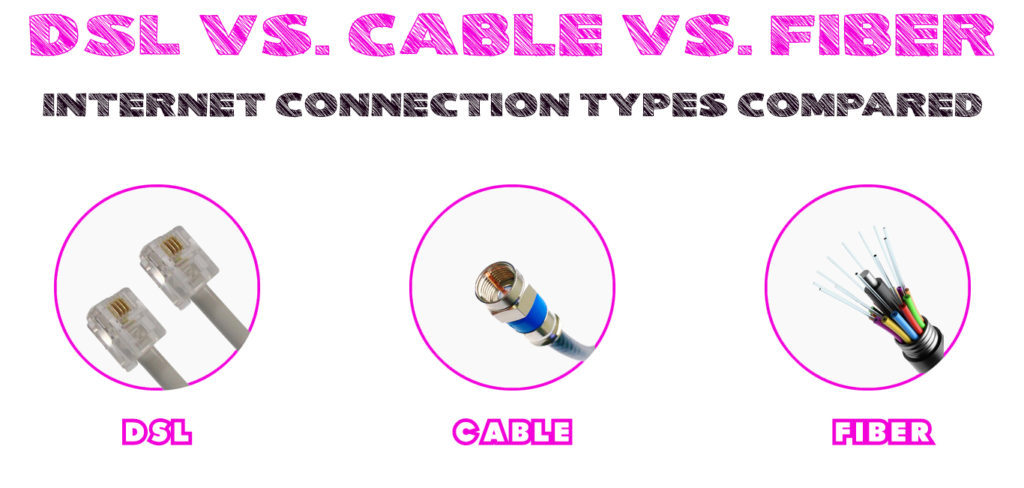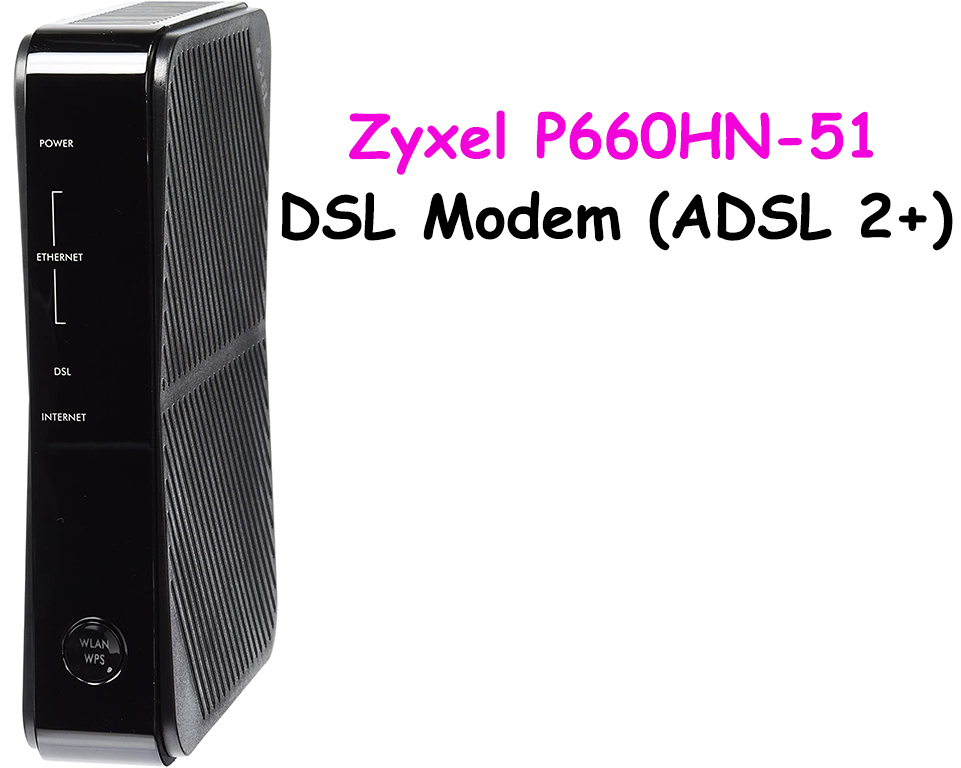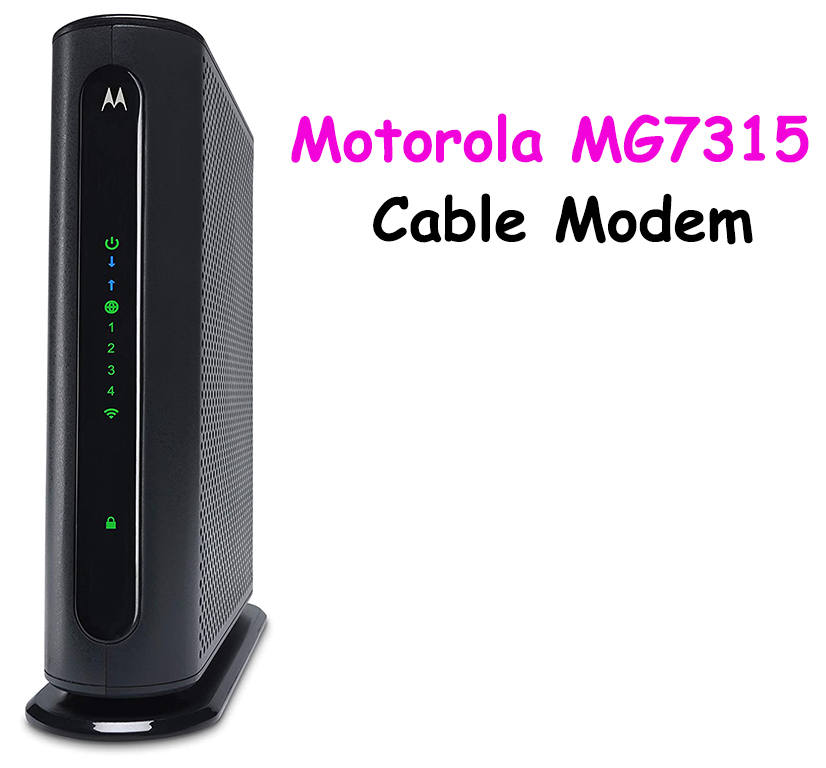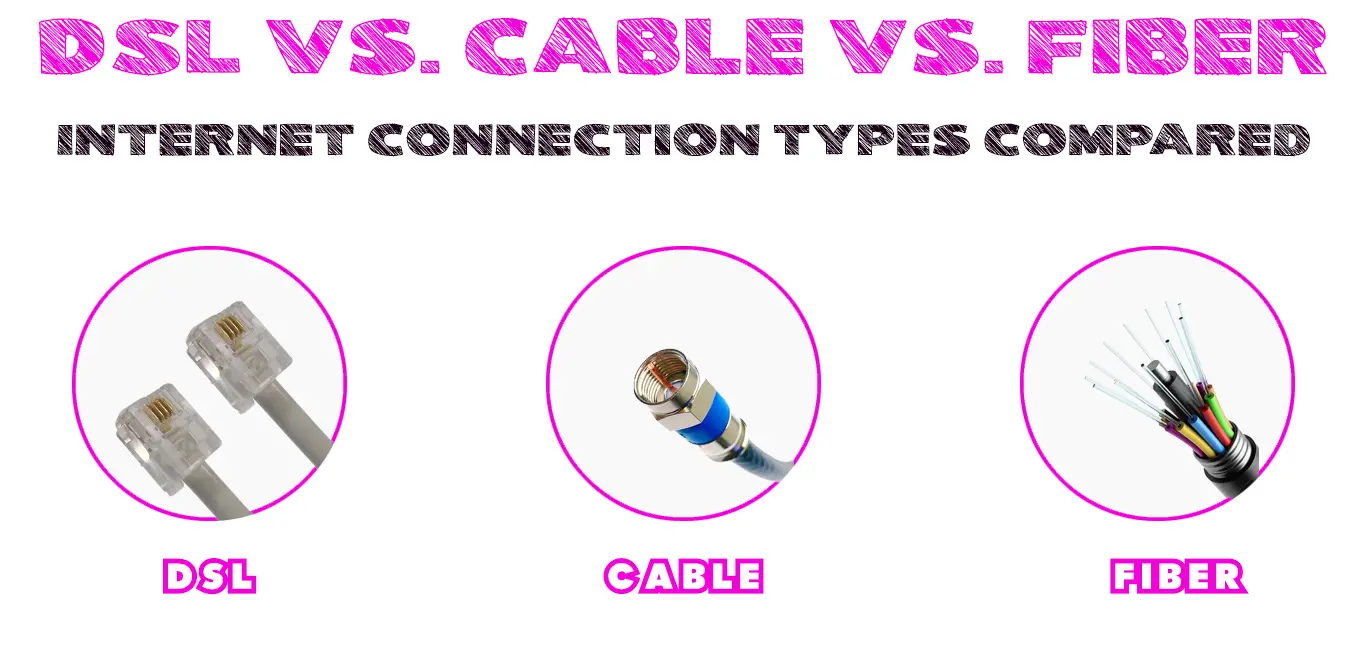DSL, cable, and fiber are words that will definitely pop up when comparing different internet connections. These three broadband technologies are the most common internet options that define how we access the web. They facilitate data transmission from your ISP to your home or office and vice versa.
You can choose between DSL, cable and fiber, and a few others. The broadband technology you select depends on your internet needs and the physical infrastructure of your premises.
This post highlights the differences between DSL vs. cable vs. fiber to help you decide which internet option is ideal for you. Keep reading to find out more!

CONTENTS
What is DSL?
DSL stands for Digital Subscriber Line and is a broadband technology that provides internet access via conventional telephone lines. It transmits data using high-frequency bands to avoid interfering with regular voice services.
Unlike the old dial-up connection, which is painstakingly slow and similarly uses phone lines, DSL provides high-speed internet using highly advanced equipment, including a DSL modem.
Besides, telephone lines have a higher capacity to carry voice and data simultaneously, ensuring faster connection speeds. The downstream speeds for DSL range from 1 Mbps to 100 Mbps, while the upload speeds are anywhere from 380 Kbps to 10 Mbps, depending on the service provider.

DSL works by converting signals sent by your ISP via the telephone lines into your modem. The modem will receive these signals and decode them into signals you require to access the internet. Since the infrastructure is already in place, you only need a modem from your ISP to get online.
What Is Cable Internet?
Cable internet is a broadband technology that provides high-speed internet access via coaxial wires similar to those used by your cable television service. It uses the same infrastructure set up by your cable TV provider.
Nowadays, cable companies not only provide television programs and phone services but also diversify by offering internet access to their consumers via radio frequency signals transmitted over underground coaxial wires.

Even though your service provider will transmit data over the same coaxial wires as your cable TV signals, you need a cable modem to access the internet. Your cable provider will assign you a modem once you subscribe to their internet services.
Cable internet works by transmitting data from your cable provider (ISP) via a Cable Modem Termination System (CMTS) through an underground coaxial line into your cable modem. The signals run on your cable TV network into your home, allowing you to access the web.
How Cable Internet Works
What Is Fiber Internet?
Fiber is the latest entrant in the broadband technology space. It provides high-speed internet access by transmitting data in infrared light pulses via fiber optic cables instead of copper wires or coaxial cables.

Since fiber internet uses light and laser signals to transmit data, it is undoubtedly the fastest and most reliable broadband technology today. Besides, fiber optic cables can transmit multiple binary data packets simultaneously over long distances with minimal distortion and low attenuation of the signals.
Fiber optic cables are incredibly tiny in diameter, so an OSP engineer has to bundle several of these wires together to form a larger trunk cable before installing it underground.
Fiber internet is so popular with users because of the fast internet speeds. It increases downstream and upstream rates, with subscribers enjoying speeds of 250 Mbps to 1 Gbps in either direction. Besides, many people can access the network without experiencing performance loss.
How Does Fiber Internet Work?
Differences Between DSL, Cable, and Fiber
DSL, cable, and fiber are fast broadband technologies that provide high-speed internet access. Despite facilitating the same service, these internet options have significant differences. These include:
- Data transmission
The main difference between DSL, cable, and fiber is how they transmit data to your internet network. DSL sends and receives data over conventional telephone lines, while cable uses your cable network infrastructure to transfer data over coaxial cables. Fiber internet transmits light and laser pulses over fiber optic cables installed underground.
- Data throughput
Data throughput is the amount of data transmitted from one place to another over a network in a given period. It refers to the amount of traffic from your ISP to your home or office network and vice versa. DSL has the lowest data throughput, followed by cable internet since they use phone lines and coaxial cables, which do not have much capacity. Fiber internet has the highest data throughput as optical cables can carry loads of signals simultaneously with minimal distortion.
- Average speeds
Another significant difference between DSL, cable, and fiber is the data rates they support. Fiber internet is the fastest broadband technology, with average speeds ranging from 250 Mbps to 1 Gbps. Cable internet is fast but cannot compete with fiber since optic cables boast 10,000x more usable bandwidth than coaxial cables. DSL is the slowest of the three internet options, with speeds not exceeding 100 Mbps.
- Interference
Extreme weather and electromagnetic interference can destabilize your internet connection, leading to frequent downtimes. DSL and cable internet are more susceptible to these challenges since they utilize phone lines and coaxial cables, which are prone to distortion. Fiber internet uses light and laser signals, effectively overcoming this challenge.
- Performance and signal quality
The performance of fiber internet is incomparable to that of DSL and cable internet. Many people can share a fiber connection simultaneously without experiencing performance loss or signal quality degradation. Unfortunately, this is not the case with DSL and cable internet. The performance of these two technologies tends to drop during peak times.
- Availability
DSL and cable internet are widely available since most homes have telephones and cable TV. However, these two technologies are not future-proof since many people are now opting for mobile phones instead of landlines and on-demand video platforms like Netflix instead of cable TV. Fiber internet has limited coverage, but plans are underway to increase its countrywide reach.
- Cost
DSL and cable internet plans are relatively more affordable than fiber internet since the two broadband technologies run on pre-existing infrastructure. With fiber internet, an engineer has to lay fiber optic cables to your home, raising the overall cost of the service.
Differences Between DSL, Cable, and Fiber
Benefits of DSL Internet
- Data and voice bundle
DSL internet runs on telephone lines. When you subscribe to a DSL internet plan, you enjoy a data and voice bundle at a discounted rate. Moreover, you can access the internet and use the phone line without interfering with the connection. DLS transmits data using high-frequency bands, preventing any interference.
- Wide coverage
DSL has a broader coverage countrywide since many homes and commercial premises already have telephone lines. Moreover, installing a DSL connection is straightforward and hassle-free, given that it does not require additional wiring. Instead, it uses pre-existing infrastructure.
- Guaranteed bandwidth
DSL internet plans are reliable and consistent since there are no shared connections. Each client has a dedicated service line, guaranteeing the bandwidth you need to undertake your online tasks. A dedicated line also prevents performance loss in the long term.
- Relatively Affordable
DSL connections are relatively more affordable than other internet options. First, the network runs over pre-existing infrastructure, significantly cutting installations costs. Besides, most providers will give you a DSL modem once you subscribe, so you don’t have to buy one separately.
Cons of DSL Internet
- Slow speeds
Although faster than dial-up connections, DSL internet is painstakingly slow as per current standards. The average download speeds do not exceed 100 Mbps, with many service providers allowing downstream rates of only 1 to 35 Mbps. These speeds are only ideal if you want to use the internet for lighter tasks such as sending and reading emails, sharing small files, browsing articles, researching the web, and visiting social media sites.
- Less effective
DSL is less effective than other internet options since your connection’s quality and speed depend on your proximity to the service provider. The larger the distance from the main distribution point, the less effective your internet access is. You might experience frequent downtimes if you reside more than 18,000 feet from the ISP hub.
- Data caps
Some DSL service providers enforce data caps with their internet plans, limiting the data you can access or download every month. You may have to purchase additional data to continue accessing the web, subsequently raising your monthly internet costs.
- Security concerns
DSL connections have security concerns since it is easy for hackers to tap your phone line and eavesdrop or monitor your online activities without your knowledge.
Benefits of Cable Internet
- Faster speeds
Cable internet is comparatively faster than DSL connections, with end-users enjoying average speeds of up to 500 Mbps. If you have a DOCSIS 3.1 or 4.0 cable modem, you can experience download speeds of up to 10 Gbps.
- Internet and cable TV bundle
When you subscribe to a cable internet plan, you will likely receive a discounted cable TV bundle with your internet subscription. Besides, installation costs are relatively affordable since the network runs on the pre-existing infrastructure. Your provider will also give you a cable modem to access the internet.
- Improved reliability
Cable internet supports hard-wired connections, making it more reliable than wireless connections susceptible to interference and downtimes caused by physical obstructions. Moreover, cable delivers consistent and dependable speeds in the long term regardless of the proximity to your service provider.
- Enhanced security
Cable internet has fewer security concerns since it is somewhat tricky for hackers to intercept signals traveling through coaxial cables. However, this does not mean you are less vulnerable to attacks. You must install a hardware firewall or disable file-sharing to enhance your network security.
- Wide coverage
Cable TV has a broader coverage countrywide, and since most homes already have cable TV, installing cable internet is a breeze. Your provider will use the pre-existing infrastructure to set up your internet connection.
Cons of Cable Internet
- Prone to interference
One of the most significant downsides of cable internet is that it is susceptible to electromagnetic interference and extreme weather. The coaxial cables consist of copper and aluminum wires, prone to interference. Storms and heavy downpours can also affect signal transmission and cause downtimes.
- Performance loss
Cable internet is a gigantic network of other home networks, meaning you might notice performance loss and slower speeds during peak hours when everyone is using the internet.
- Tied with a TV subscription
Most cable companies compel clients to subscribe to their cable TV packages and their internet plans. The providers tie their internet plans with a cable TV subscription, meaning you have to subscribe to the two to access the internet.
Benefits of Fiber Optics
- High-speed internet
Fiber is the faster and most reliable internet connection today. The technology transmits data in light and laser pulses over fiber optic cables, with users enjoying average connection speeds of 1 Gbps.
- Greater data throughput
Fiber internet has the highest data throughput as optical cables can carry loads of signals simultaneously with minimal distortion and low latency and attenuation. Greater data throughput, making fiber ideal for heavy streaming, online gaming, and large file transfers.
- Enhanced security
Since fiber optic cables do not radiate signals like other internet options, the chances of hackers intercepting your network and monitoring your traffic are minimal. Besides, it is easy to recognize hacking attempts and breaches due to the various security mechanisms associated with fiber internet.
- Future-proof
Fiber optics is the future of internet technology. Adopting it early can give you a competitive edge and future-proof your network.
Cons of Fiber Optics
- Limited coverage
Only about 40% of the country has access to fiber internet since the technology is relatively new. However, plans are already underway to increase coverage in other regions.
- Relatively expensive
Fiber internet is relatively expensive compared to other internet options. There is no pre-existing infrastructure, meaning the installation costs can go up significantly.
- Delicate wiring
Fiber optic cables are prone to physical damage. The wires are thin and highly delicate, making them susceptible to accidental destruction. Any slight damage can disrupt the entire service.
Conclusion
Choosing between DSL, cable, and fiber can be overwhelming, given that each broadband technology has its upsides and downsides. Understanding your specific needs can help you narrow down your options and select the ideal plan.
If you usually use the internet to send emails, read articles, and visit social media platforms, a DSL connection or a cable internet plan might be the right choice. A fiber internet plan is ideal if you are into heavy streaming, video calling, online gaming, and large file transfers.
Now that you know the differences between DSL vs. cable vs. fiber, you can make a more informed choice.

Hey, I’m Jeremy Clifford. I hold a bachelor’s degree in information systems, and I’m a certified network specialist. I worked for several internet providers in LA, San Francisco, Sacramento, and Seattle over the past 21 years.
I worked as a customer service operator, field technician, network engineer, and network specialist. During my career in networking, I’ve come across numerous modems, gateways, routers, and other networking hardware. I’ve installed network equipment, fixed it, designed and administrated networks, etc.
Networking is my passion, and I’m eager to share everything I know with you. On this website, you can read my modem and router reviews, as well as various how-to guides designed to help you solve your network problems. I want to liberate you from the fear that most users feel when they have to deal with modem and router settings.
My favorite free-time activities are gaming, movie-watching, and cooking. I also enjoy fishing, although I’m not good at it. What I’m good at is annoying David when we are fishing together. Apparently, you’re not supposed to talk or laugh while fishing – it scares the fishes.

